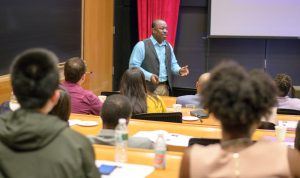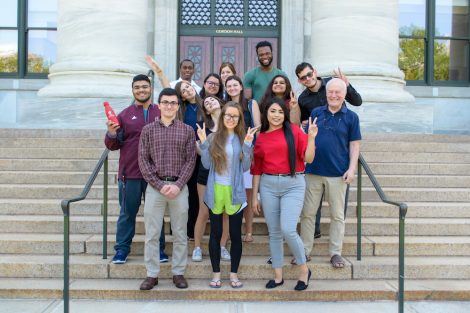August 6, 2019 – A summer crash course at Harvard T.H. Chan School of Public Health helped a dozen undergraduates from across the U.S. learn how to use quantitative skills to improve health on a wide scale.
During the six-week Summer Program in Biostatistics and Computational Biology—aimed at attracting underrepresented minorities into the field of biostatistics—students took noncredit courses in biostatistics and epidemiology. They learned about data collection and analysis methods, participated in group research projects guided by faculty mentors, postdocs, and graduate students, and attended talks on a wide range of public health topics.
“The talks were great. The classes were amazing. And the mentorship was great, too,” said Ian Reyes, a physics major and a rising junior at the University of Texas at El Paso. “The most important thing I learned was how diverse the field of public health is and the massive amount of work that biostatisticians can do in so many different areas.”
For his research project, Reyes was part of a student team that looked at data on neurodevelopmental issues, such as problems with motor and cognitive skills, that affect infants who have had cardiac surgery. Working under the mentorship of David Wypij, senior lecturer on biostatistics, Reyes and his team analyzed ways to use the data to predict potential outcomes related to this surgery.
Another student in the program, Ana Stevens—a rising junior who studies biology at Pomona College in Claremont, California—worked on a research project that examined the relationship between bacteria in the gut microbiome and the risk of coronary artery disease and type 2 diabetes, under the mentorship of Liming Liang, associate professor of statistical genetics. “It was really cool to look at different areas of the microbiome and find connections to those diseases,” Stevens said.
The summer program for undergraduates, now in its 25th year, is directed by Marcello Pagano, professor of statistical computing. Pagano said the program’s focus on drawing more underrepresented minorities into the field of biostatistics is crucial. Noting that life expectancy for African Americans is several years less than for whites in the U.S., he said that boosting interest in biostatistics among students—who may then go on to careers in the field—could help reduce that discrepancy. “The best way to disturb the status quo is to get the target group involved,” he said.
Faculty mentor Rafael Irizarry, professor of biostatistics, said the program exposes students to a side of statistics that they might not encounter during their undergraduate years. The program’s approach is, “‘Here’s a problem, here’s some data, let’s answer a question’,” he said, adding, “Every summer it’s the same—the students get really into the problem and really want to figure it out. They’re energetic, eager to learn, and positive.”
The ability to ‘play in any backyard’
The program wrapped up on July 18 with the annual “Pipelines into Biostatistics” symposium in Kresge G-3, at which students gave presentations about their research. The event included a keynote address from DeJuran Richardson, an expert in conducting large clinical trials in the areas of cancer, HIV, heart disease, stroke, and neurological disorders. Richardson directs biostatistics and epidemiology at Rush University Medical Center in Chicago and is also chair of math and computer science at Lake Forest College in Lake Forest, Illinois.

He added that biostatistics “is one of the handful of disciplines that affords one the ability to pivot in so many different directions.” He ticked off the career opportunities that abound for biostatisticians—in academia, at think tanks, in the pharmaceutical industry, in financial services, in government, in public policy. “One of the best things about statistics and biostatistics is that it allows you to play in any backyard you want to,” Richardson said. “It affords you the ability to get off the beaten path.”
Richardson stressed the importance of boosting diversity in the field of biostatistics, partly to bring different perspectives to the work and partly because the field needs more experts in general.
The symposium included a panel featuring program alumni and members of the summer program’s advisory board discussing their career choices and how to promote diversity in STEM fields. The event also featured remarks from Pagano; from Wendy McRae-Owoeye, Harvard Chan School Dean for Diversity, Inclusion, and Belonging; and from John Quackenbush, chair of the Department of Biostatistics.
The Summer Program in Biostatistics and Computational Biology is one of several summer offerings from the Department of Biostatistics that aim to pique interest in the field among underrepresented minorities. Others include a Post-Baccalaureate Internship Program for college graduates who are interested in or planning to attend a graduate degree program in biostatistics; a one-month intensive course in biostatistics and computing called StatStart, for high school students in greater Boston; and a one-week introduction to programming and machine learning for high school students called Data Science in Action: Convolutional Neural Networks for Self-Driving Cars.
photos: Shaina Andelman
